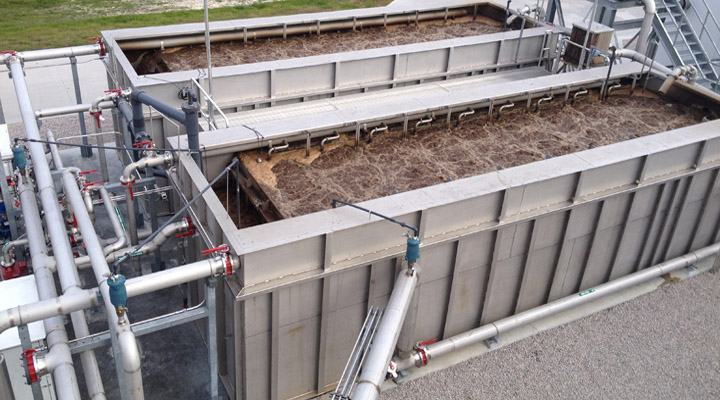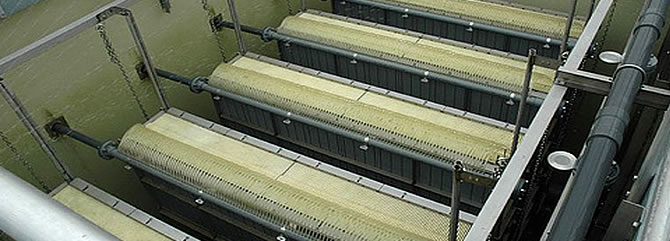How to Optimize Membrane Bioreactor Performance for Maximum Efficiency
How to Optimize Membrane Bioreactor Performance for Maximum Efficiency
Blog Article
Recognizing Membrane Layer Bioreactors: The Future of Wastewater Treatment
Membrane bioreactors (MBRs) represent a significant development in the area of wastewater therapy, integrating organic procedures with advanced membrane layer purification to enhance effluent high quality. As international water scarcity and strict governing frameworks become progressively pushing issues, MBR innovation uses a reliable reaction with its capacity to decrease footprint and optimize resource healing.
What Are Membrane Layer Bioreactors?

The core elements of MBR systems consist of a bioreactor where microbial task takes place and a membrane layer device that filterings system the combined alcohol. This twin functionality enables the simultaneous degradation of raw material and solid-liquid splitting up in a solitary action. MBRs can run in both immersed and exterior arrangements, with immersed systems being a lot more typical because of their small style and operational efficiency.
The adoption of MBR technology has obtained grip in numerous applications, varying from local wastewater therapy to industrial effluent management. MBRs are particularly useful in circumstances where room is restricted or strict effluent top quality criteria need to be satisfied. By maintaining a high focus of microbes within the bioreactor, MBRs improve the degradation of natural contaminants, thus yielding greater treatment efficiencies contrasted to standard techniques.
Key Advantages of MBR Technology
The combination of biological therapy with membrane filtering in MBR systems offers many advantages that establish it apart from standard wastewater treatment techniques. Among the main advantages is the enhanced effluent high quality. MBRs effectively eliminate put on hold virus and solids, accomplishing higher degrees of filtration that meet rigid discharge standards and help with water reuse applications.

Another considerable benefit is the lowered sludge production. MBR systems generate less excess sludge, causing reduced disposal prices and a decline in environmental impact. The closed nature of the membrane system lessens the threat of smell exhausts and enhances overall process control.
Lastly, MBRs are flexible and adaptable, making them appropriate for different wastewater kinds, consisting of commercial and local resources. The capacity to incorporate with innovative therapy modern technologies better boosts their performance, making MBRs an encouraging option for the future of wastewater monitoring.
Obstacles and Limitations of MBRs
While MBR innovation uses many advantages, it also faces several challenges and constraints that can influence its extensive adoption. One significant challenge is the high funding and functional costs connected with my latest blog post MBR systems. The initial investment for membrane layer materials and the needed framework can be significant, making it much less available for smaller markets or towns.
Additionally, membrane layer fouling stays a vital issue that can diminish system efficiency and increase upkeep needs. Fouling occurs when solids, raw material, or microorganisms collect on the membrane surface area, causing decreased leaks in the structure and needing frequent cleansing or replacement.
An additional limitation entails the complexity of the modern technology. MBR systems need skilled employees for operation and upkeep, which can be a barrier in areas with limited technical proficiency. The disposal of invested membrane layers presents environmental problems, as the materials are commonly not biodegradable and can contribute to throw away management difficulties.
Last But Not Least, while MBRs can effectively treat her response a vast range of wastewater, they may not be ideal for all applications, specifically those with high concentrations of fats, oils, and greases, requiring more research and development to attend to these constraints.
Applications of Membrane Bioreactors
In various industries, membrane layer bioreactors (MBRs) have actually arised as a versatile service for wastewater treatment (Membrane Bioreactor). Their applications cover metropolitan, commercial, and farming setups, showcasing their adaptability and effectiveness in diverse atmospheres. In local wastewater therapy plants, MBRs dramatically boost effluent top quality, enabling water reuse and reducing the environmental impact of discharged wastewater
Industrially, MBRs are employed in food and beverage handling, fabric production, and pharmaceutical manufacturing, where they properly deal with high-strength waste streams. Their capacity to take care of differing and changing tons pollutant concentrations makes them particularly important in these sectors. Additionally, MBRs facilitate the elimination of virus, put on hold solids, and raw material, adding to conformity with rigorous discharge laws.
In agriculture, MBRs are significantly made use of for dealing with agricultural runoff and animals wastewater, allowing the healing of nutrients for fertilizer manufacturing. They likewise aid in the treatment of greywater for watering, promoting sustainable water monitoring methods.
The flexibility of MBRs is further shown by their combination with other modern technologies, such as anaerobic food digestion and advanced oxidation procedures, improving overall efficiency and resource recuperation in wastewater treatment systems.
The Future of Wastewater Treatment
Improvements in innovation and an expanding emphasis on sustainability are forming the future of wastewater treatment. Membrane bioreactors (MBRs) exhibit this shift by incorporating biological therapy processes with membrane layer filtration, causing top quality effluent ideal for reuse. The pattern in the direction of circular economic situations is triggering centers to embrace MBRs for their capacity to recover see page sources, such as water and nutrients, from wastewater.
Developments in membrane layer materials and setup are boosting the effectiveness and long life of MBR systems, decreasing functional costs and energy intake. Smart technology combination, consisting of real-time monitoring and automated control systems, is additional maximizing performance and allowing anticipating maintenance, therefore decreasing downtime.
Furthermore, societal assumptions and governing pressures are pushing industries and communities to take on even more sustainable practices. Membrane Bioreactor. The shift towards decentralized wastewater therapy remedies is gaining traction, permitting local therapy that lowers transportation costs and power use
Final Thought
Membrane bioreactors (MBRs) represent a transformative strategy to wastewater treatment, integrating organic processes with advanced membrane innovation. The benefits of MBRs, consisting of improved effluent top quality, lowered spatial needs, and reduced sludge manufacturing, place them as a viable solution amid growing urbanization and stricter ecological regulations. Despite existing challenges, the ongoing technology in membrane layer products and functional methods guarantees to boost the effectiveness and adoption of MBRs, ensuring their pivotal role in the future of lasting wastewater monitoring.
Membrane layer bioreactors (MBRs) represent a noteworthy innovation in the area of wastewater therapy, incorporating biological processes with innovative membrane layer filtering to enhance effluent quality.Membrane layer bioreactors (MBRs) integrate biological treatment procedures with membrane layer filtering to efficiently treat wastewater.The assimilation of biological treatment with membrane layer filtering in MBR systems provides numerous benefits that set it apart from traditional wastewater therapy techniques. Membrane layer bioreactors (MBRs) exhibit this shift by incorporating biological therapy procedures with membrane filtration, resulting in high-quality effluent ideal for reuse.Membrane bioreactors (MBRs) stand for a transformative technique to wastewater treatment, incorporating biological procedures with advanced membrane layer technology.
Report this page